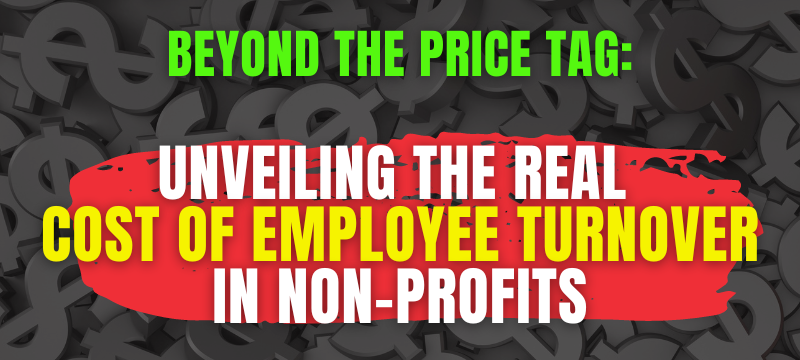This blog was originally posted on www.TheNPOGroup.com Membership fees often represent a significant share of…

Beyond the Price Tag: Unveiling the Real Cost of Employee Turnover in Non-Profits
Not long ago, my team at the accounting firm faced a challenge that’s all too common in the business world. Right before our busiest season, one of our accountants, who had been underperforming throughout the year, decided to leave for another opportunity. In our line of work, departing during peak times is a major issue, and her decision left me both disappointed and concerned about the potential impact on the rest of the team.
To ensure stability, I went the extra mile. I had conversations with every affected staff member, reassuring them about their roles and responsibilities. I promised them we’d find a replacement soon and made it clear that they wouldn’t be burdened with excessive work. This experience was a real eye-opener about the deeper implications of employee turnover.
This got me thinking about how such situations unfold in non-profits and associations, where resources are often more limited. If we felt this strain despite being well-prepared, the effects on organizations with fewer resources could be significantly greater.
Hiring the wrong person in your organization, especially in the non-profit and association sectors, can be more costly than many realize. The expenses start accumulating right from the outset:
- Recruitment Expenses: Advertising a position isn’t cheap, especially if you’re aiming for wide reach or specialized roles. Sometimes, you might even need to bring in recruitment agencies, which adds to the cost. And let’s not forget the administrative side of things – processing applications, conducting interviews, and the like – all of which require time and resources.
- Training Costs: Once you’ve got someone on board, there’s the matter of getting them up to speed. Training new employees is a necessary investment, but it can be a significant one. This is particularly true for roles that require specific skills or in-depth knowledge of the organization’s operations.
- Termination Pay: If things don’t pan out, there could be costs associated with severance or termination pay. This not only affects the organization’s finances but can also be a legal minefield if not handled correctly.
- Lost Productivity: The time spent on recruiting and training is time not spent on actual work. During these phases, there’s often a dip in productivity, and it can take a while for the new hire to reach the productivity levels of their predecessor.
- Impact on Morale: This is harder to quantify but just as important. High turnover, or a new hire that doesn’t fit well with the team, can affect the morale of your existing staff. It can lead to a domino effect of disengagement and decreased productivity.
While the more visible costs of employee turnover are immediately felt, they barely scratch the surface. Subtler yet significant implications can ripple through an organization, particularly evident in the complex environments of non-profits and associations, where turnover can upset the delicate balance of operations and team dynamics.
Hidden Costs of Employee Turnover
- Disrupted Processes and Lost Knowledge: Turnover often leads to the loss of critical institutional knowledge and established processes. When key staff members leave, they take their unique understanding of the organization’s operations with them, posing a challenge in maintaining continuity.
- Over-Reliance on Single Employees: Organizations sometimes find themselves overly dependent on a single employee. This over-reliance can create bottlenecks and increase vulnerability, especially if that individual leaves or lacks transparency in their operations.
- Operational Inefficiencies: Turnover can expose or exacerbate existing inefficiencies within an organization’s processes. Manual, non-automated systems are particularly prone to errors and can lead to increased workload and stress for the remaining staff.
- Increased Financial Risks: Staff changes in key financial roles can lead to increased risks, including financial mismanagement and fraud, particularly when internal controls are weak or documentation is lacking.
- Lost Opportunities for Improvement: Every turnover is a missed opportunity to improve or streamline operations. Delay in adopting modern, efficient systems due to turnover can hinder an organization’s growth and decision-making capabilities.
These hidden costs, including the loss of specialized knowledge, operational disruptions, and increased organizational vulnerability, are crucial considerations. They highlight the need for not just strategic hiring, but also for building resilient systems and processes that can withstand staffing changes.
Recently, we were called in to assist a Canadian non-profit that had hit a snag with its finance team. The situation was tricky: their general accountant and controller, who had been with the organization for two and one years respectively, both decided to leave amid internal conflicts.
Upon our arrival to manage the transition, we uncovered a range of unexpected challenges. The organization’s financial processes were in disarray – hardly anything was documented, and tasks like membership management and fee collection were being handled manually. This lack of structure was a big red flag.
Further exploration revealed even deeper issues. Receipts were scattered and not filed systematically, and the membership team had been piling their responsibilities onto the already strained finance team. A clear sign that some streamlined automation was sorely needed.
The manual approach to managing collections was fraught with potential errors. Financial reporting within the organization was inconsistent at best, and budgeting and forecasting processes lacked any formalized approach or clear responsibility.
When it comes to the costs of this turnover, it wasn’t just about hiring and severance fees. The real price tag included training new staff in these inefficient systems, rectifying previous errors, and the lost opportunity of not having implemented effective automation solutions earlier.
One of the most telling signs of the disorganization we faced was the missing documentation – we couldn’t locate half of the necessary receipts. This situation highlighted the often-overlooked costs of employee turnover, especially when compounded by a lack of robust, efficient processes.
Case 2: Ten-Year Client with a Single Finance Gatekeeper
Another example comes from a client we’ve worked with for over a decade. They had a unique situation where one person was responsible for all the organization’s finances. This individual maintained exclusive access to bank accounts, financial statements, and even audited financials, effectively gatekeeping crucial financial information. To compound the issue, all office systems were set up using this person’s personal contact details and credit cards. Consequently, the former Executive Director faced significant hurdles in accessing vital financial data for decision-making.
When a new Executive Director came on board, their attempts to review the financial records were immediately rebuffed. This lack of transparency prompted the Executive Director to reach out to the external auditor. It was then discovered that the financial controller’s approach to managing the finances was not only inefficient but also costly. The auditor revealed that due to the financial controller’s mismanagement, the organization was incurring double the audit fees than what would typically be expected.
This scenario underscores a critical risk in allowing a single individual to have complete control over an organization’s finances without oversight or transparency. It also highlights the potential financial repercussions that can arise from such a setup, impacting not just the day-to-day operations but also leading to increased external costs, like in the case of audit fees.
What can you do to minimize your risk? The answer: Streamlining Your Non-Profit’s Financial Health
So, we’ve seen what a mess unplanned employee turnover can create, right? It’s not just about finding someone new. There’s a whole world of processes and knowledge that walks out the door with them. But, here’s the silver lining: you can turn things around with some smart strategies.
Why Standardize Your Accounting?
Think of standard accounting practices as your financial safety net. They keep things running without a hiccup, even when your staff changes. This isn’t just about dodging risks; it’s about making your day-to-day financial tasks a lot smoother and more efficient.
Considering Outsourcing? Here’s Why It’s a Good Move
Not every organization can (or needs to) have a full-blown finance team in-house. Outsourcing can be a game-changer. It’s like having your own team of financial wizards, but without the overheads. Plus, you get the added advantage of tried-and-tested practices from a broad spectrum of industries.
How Can OTUS Group Help?
This is where we come in. At OTUS Group, we’re not just about balancing books; we’re about bringing in best practices that we’ve polished over the years, working with a variety of organizations.
- We can help you set up accounting guides that are tailor-made for your needs.
- Outsourcing? We’ve got you covered with solutions that fit right into your financial strategy.
- And the best part? We bring insights from across the board to make sure your operations are as efficient as they can be.
Every non-profit or association is unique, and we get that. Our goal is to ensure that your financial systems aren’t just robust but also flexible enough to match your specific needs. Partner with us, and let’s build a financial foundation that’s ready for anything – growth, change, you name it.
Reach out to us here at OTUS Group, and let’s chat about getting your financial management on the right track.



